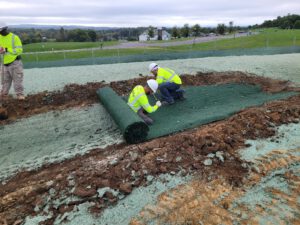Erosion causes damage to rivers and bodies of water, impacts ecosystems, and reduces plant growth. Effective erosion control is essential for protecting the environment, wildlife, and human property.

Techniques like terracing, swales, and changing slope grades help stabilize the soil. Barriers such as silt fences and traps prevent sediment from entering runoff. Visit https://dockbuildingcharleston.com/ to learn more.
Plants can act as a natural erosion control by binding soil together, stabilizing slopes, and providing shade to prevent excessive water loss. They also help to reduce soil erosion by slowing runoff, absorbing rainfall, and reducing sediment concentrations. Planting vegetation is a cost-effective and sustainable way to improve the health of your land. It is important to choose vegetation that is native to the area, as it will better adapt to the climate and soil conditions and be resistant to pests. Avoid invasive plants like Himalayan blackberry or English ivy, as they have low erosion control values and may out-compete other desirable species.
Increasing vegetation coverage can drastically decrease soil erosion rates by restricting the flow of water, decreasing runoff volume, and reducing sediment concentrations. In addition, the presence of vegetative cover helps to protect the soil from wind and sunlight which can exacerbate erosion processes. Depending on the type of vegetation, some can also promote soil fertility and enhance wildlife habitat.
Erosion is a natural process that occurs when the nutrient-rich topsoil in fields and on slopes is displaced by water or wind. This eroded material can be carried away and lost from site, degrading cropland productivity and contaminating waterways. Similarly, erosion on construction sites can displace up to 500 tons of soil per acre, creating hazardous conditions and costly clean-up operations.
The most effective means of preventing erosion is to plant vegetation in the affected areas, particularly native plants. These plants form a web of roots that help to hold the soil together and reduce erosion. They are also adapted to the local environment and can resist drought, making them an excellent choice for construction sites.
The importance of preventing erosion cannot be overstated, as erosion can damage or destroy landscapes, crops, and infrastructure, as well as contaminate waters. Good erosion control practices can save a great deal of time, effort, and money in the long run, as well as preventing soil loss and protecting human life and the environment. Erosion control starts with proper planning and forethought to ensure that the right plants are planted in the right places to achieve the desired result.
Soil Blankets
Erosion control blankets, also known as erosion mats or jute matting, are rolled sheets of organic and synthetic fibers that can be placed on sloped ground to prevent soil movement and promote the growth of new vegetation. They are typically anchored in place by digging a shallow trench along the edge of the site. The soil in the trench is then compacted and tamped down to ensure that the blanket stays in place. Blankets may be made of woven or continuous natural or synthetic material, such as coir, jute, straw, excelsior, coconut or polypropylene.
A natural product, such as straw or coir, has the advantage of degrading quickly and promoting the growth of new vegetation. However, these products tend to snag and uproot small plants. They are also prone to being pulled apart during rainfall events, especially on steep slopes.
To avoid these problems, look for a product with a higher percentage of synthetics, which are more resistant to damage and last longer than natural materials. High-performance turf reinforcement mats (HPTRMs) are designed to withstand heavy use and offer greater tensile strength than other erosion control blankets. They are ideal for sites with little or no existing vegetation and include grading and fill areas, slopes, structural backfills, high-flow water channels, maintenance access areas and coastal and riverbank erosion protection.
Before laying an erosion control blanket, inspect the site to make sure that it is clear of debris such as branches, rocks, dirt clods and roots. Dig a trench along the edge of the site, remove the excess soil and then compact it with a shovel or tamper. This will help to anchor the blanket and prevent it from being dragged downhill during rainstorms.
Once the blanket is in place, it should be inspected for signs of damage after every rainfall. Inspect for snags, where the blanket is tangled in vegetation and pulled away from the soil, and pulls, where the runoff or weight of precipitation catches on to the matting and pulls it downhill. Check for loosened fasteners and stakes, as well as for sections of the blanket that have been flipped up by animals or the weight of rainfall.
Riprap
Riprap is large rock used to protect shore lines, river banks, bridge abutments and foundational infrastructure support against erosion from waves, wind or water scour. It can be made from a variety of materials, including granite, modular concrete blocks and rubble from building or paving demolition. Riprap is typically positioned in layers. The top layer, called the “armor layer”, catches the initial impact from waves and helps to prevent erosion from scour beneath it. The bottom, or “filter layer”, is a thick layer of smaller rocks that filter sediment from the water and help to hold the riprap in place.
It is important that the correct sized riprap be used. The larger the riprap, the more resistant it will be to erosion. The size of riprap should be determined by the location and conditions. For example, in locations with high velocity waters or steep slopes, a much larger amount of riprap is required than in calmer areas with gentler slopes. It is also crucial to monitor riprap locations after heavy storms to make sure they are still secure and not shifting or breaking apart.
While riprap does offer effective erosion control, it is not without negative environmental impacts. If not carefully chosen and placed, it can alter sediment transport and sand composition, cause habitat degradation and destroy wildlife and fish-spawning zones. However, if native plants are planted around riprap or allowed to become colonized by vegetation, many of these negative impacts can be minimized or eliminated.
For example, a rocky shoreline lined with riprap can be less harmful to sea turtles if it is designed and constructed with the presence of vegetation in mind. This not only looks better for the environment but also allows wildlife to nest and spawn on the beach without getting trapped by riprap that may obstruct their access.
Another way to lessen the impact of riprap is to use it in conjunction with other erosion control measures, like a vegetated staking. This is particularly important in areas where endangered or threatened species live or migrate through habitat-transition zones.
Check Dams
Check dams are small barriers constructed of rock, organic filter tubes or sand bags placed across the width of drainage swales and ditches to reduce flow velocity, provide a limited sediment barrier and promote a more natural stream/ditch profile. They are an important component of the sediment control system in a drainage ditch or swale, but should not be used as a substitute for major perimeter sediment trapping measures.
Construction of a check dam requires careful placement of the material to prevent scour and channel degradation around its edge. The center of the check dam should be lower than the edges, and a gravel base should be placed at the bottom of the dam to stabilize it. The dams should be checked regularly for damage, such as holes and clogging, and repaired immediately. The top of the dam should be anchored to an appropriate slope, such as the downstream hillside or adjacent swale.
The use of check dams in global arid and semi-arid regions can significantly decrease soil erosion. This is due to the effectiveness of these structures in preserving a large amount of OC during the deposition process and providing an ideal environment for cropland. The accumulation of OC in the cropland can result in an increase in food production and carbon sequestration.
These structures are an effective method for reducing eroded sediments in swales and drainage ditches with steep slopes (greater than 3 percent) and soil types conducive to gully erosion, such as sandy/silty soils. They are also appropriate for temporary, linear ditches and swales during construction activities and may be used as part of the permanent sediment control system once the site is graded and seeded.
The use of check dams can be a cost-effective option for improving water quality in urban and rural streams and rivers. They can help reduce sediment and nutrient loads to a waterbody and increase the infiltration capacity of the channel, while at the same time providing an opportunity to restore and preserve the natural habitat and wildlife that is destroyed by eroded sediments.

